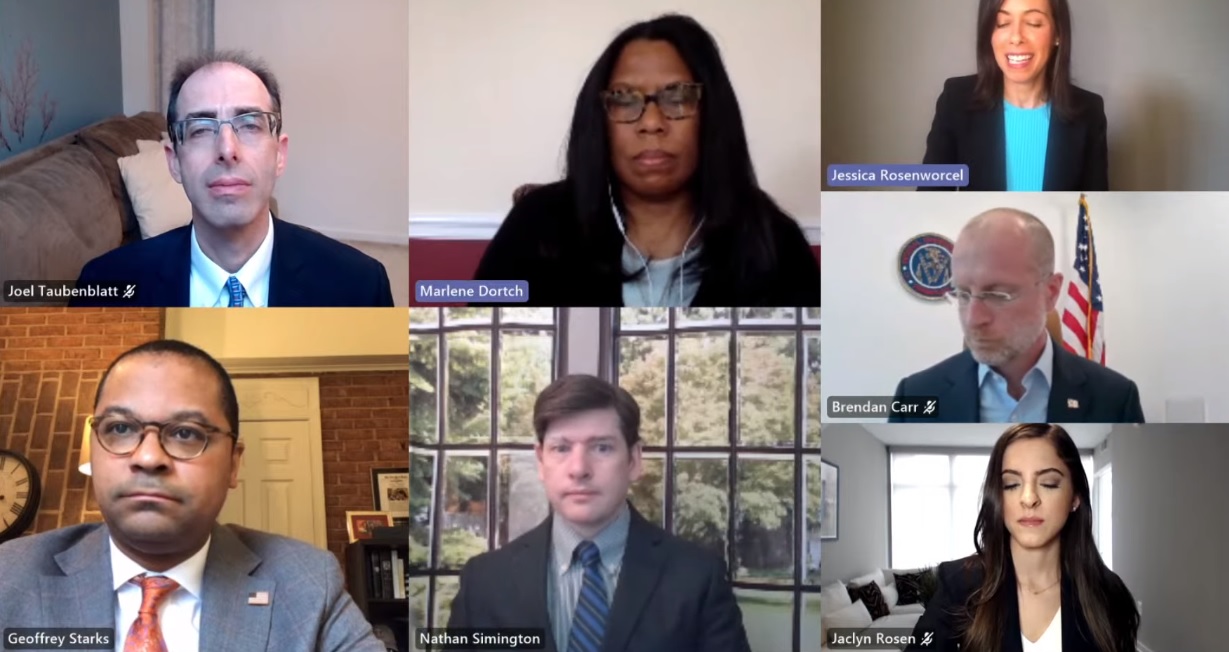FCC Opens 3.45 GHz Band for 5G Flexibility
Sticks with larger partial economic area auction blocks

The FCC has voted unanimously on how to open up a swath of high-value midband spectrum in the 3.45 GHz band--currently used by DOD for key radar applications--for commercial wireless broadband (5G) and, separately, approved proposed application and bidding processes for the auction (auction 110) of that 100 MHz.
It is seeking comment on those auction processes.
The FCC voted to allocate the 3.45-3.55 GHz band for flexible use, complete the relocation of secondary non-federal commercial users and sunset amateur use of a portion of the band.
Also Read: DOD Agrees to Share Midband Spectrum
The FCC is auctioning the 100 MHz spectrum in 10 MHz spectrum blocks--as commissioner Geoffrey Starks had advocated--with a 40 MHz limit on how much any one bidder can acquire in a single partial economic area (PEA). Cable operators had argued that using those larger PEAs would result in less than robust participation in the auction by competitors to the big telecoms and had asked the FCC to reconsider that proposal.
“I appreciate that my colleagues agreed with my request to reduce the size of the spectrum blocks in the band to 10 megahertz," said Starks. "This change – coupled with the 40 megahertz spectrum aggregation limit -- should increase competition, encourage more efficient bidding, and create opportunities for smaller bidders, particularly the rural and regional carriers that are critical to bringing advanced services to our hardest-to-reach communities.”
The FCC will provide a $25 million bidding credit for small businesses and a $10 million credit for rural providers.
Commissioner Brendan Carr, who concurred in part, would have preferred the FCC not impose an up-front 40 MHz aggregation limit, but said the item got a lot of things right, including licensing the spectrum "over geographic areas that line up with our approach in C Band and that are well-suited for macro operations."
Acting chair Jessica Rosenworcel said the item has the most aggressive buildout obligations of any 5G spectrum auction, with an infrastructure buildout twice as fast as required in other 5G bands.
Congress mandated in the Consolidated Appropriations Act that the FCC come up with a system of competitive bidding by year's end for the 100 MHz of spectrum the Defense Department identified for sharing in the band.
Congress has set a December 2021 deadline for auctioning the 3.45 GHz band. The FCC is planning to start the auction in October.
The auction will consist of a clock phase, with bidding on spectrum blocks, and an assignment phase among the winning bidders for specific frequencies. There is a reserve price on the spectrum of $14 billion-plus.
"NATE [The Communications Infrastructure Contractors Association] commends the FCC for its approval today of a second report and order that will make more mid-band spectrum available for 5G services,” said director of legislative & regulatory affairs Jim Goldwater. “The Association is excited by efforts by the FCC and Congress to make more mid-band spectrum available for fifth generation wireless services. Additional access to spectrum, particularly in the mid-band range, will advance the country’s goals of expanding 5G while providing more deployment opportunities for our member companies and their hard-working technicians."
“We applaud Acting Chairwoman Rosenworcel and the FCC for their swift action to bring the 3.45 GHz band to auction under a framework that will help build our 5G Economy and close the digital divide," said Meredith Attwell Baker, president and CEO or CTIA, the wireless association. "Wireless services are helping to jump start our economic recovery, creating jobs and providing critical connections at a time when so much of our lives has moved online. Licensed mid-band spectrum plays a vital role in enabling our world-leading mobile networks, and we look forward to a successful auction later this year.”
“We applaud the FCC's efforts today to accelerate 5G deployments for American consumers and businesses," said Ligado EVP and chief legal officer Valerie Green. "By voting to make available more mid-band spectrum, the FCC is increasing access to a key resource that will help create robust next-generation networks across the country and support efforts to modernize our country’s infrastructure."
Multichannel Newsletter
The smarter way to stay on top of the multichannel video marketplace. Sign up below.
“The FCC’s vote today was a missed opportunity to take a step back and open up a much larger amount of 3 GHz military spectrum using a sharing framework that enables a wider variety of users and use cases," sid Michael Calbrese of New America's Open Technology Institute. "Unfortunately, in a Commission divided 2-2, the combination of a statutory auction deadline and the need to raise over $14 billion to clear military radar has resulted in a framework that makes the licenses affordable only to the biggest mobile carriers. We expect a repeat of the recent C-band auction, in which AT&T and Verizon won 90 percent of the licenses.”
Contributing editor John Eggerton has been an editor and/or writer on media regulation, legislation and policy for over four decades, including covering the FCC, FTC, Congress, the major media trade associations, and the federal courts. In addition to Multichannel News and Broadcasting + Cable, his work has appeared in Radio World, TV Technology, TV Fax, This Week in Consumer Electronics, Variety and the Encyclopedia Britannica.

